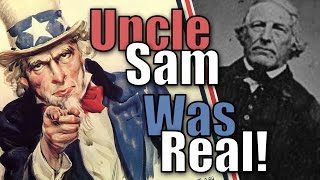What Rabbit Will Emerge? (1813)
“Oh, say can you see….” an elderly man, sporting a white beard on chiseled face, wearing a top hat sprinkled with stars? If the date is July 4, the answer is most certainly yes. Most likely, he is at the head of a parade, standing on his trademark stilts. While Uncle Sam is the mainstay of Americana, lost in the lore is his historical counterpart, Samuel Wilson.
While Britain has John Bull and France has Marianne, the United States has Uncle Sam. The man behind the icon was born in Arlington, Massachusetts, not on July 4, but rather on September 13, 1766, the son of Scottish immigrants. At age fifteen, he fought in the Revolutionary War; afterwards, he, along with his brother Ebenezer, settled in Troy, New York. In his adopted town, Samuel amassed wealth from pursuits such as distiller, merchant, brickmaker, and farmer. His marriage to Betsey Mann made him the owner of a peanut farm. Well regarded by his community, neighbors dubbed him Uncle Sam. 
As the meat inspector for the Continental Army, Sam stamped the cartons of pork and beef earmarked for delivery to American troops poised to invade Canada during the War of 1812 with the designation, “U.S.” At the time, as the initials were not commonly associated with the country, when a worker inquired as to what they stood for, someone volunteered that the letters referred to the supplier, Uncle Sam Wilson. The story spread and segued into the patriotic symbol endlessly reproduced in advertisements, political cartoons, and merchandising. As with Forrest Gump, Sam interacted with many historical events. The Beat poet, Allen Ginsberg, wore an Uncle Sam top hat for a Central Park peace rally during the Vietnam War; Jerry Garcia of The Grateful Dead referred to him in a song, the U.S. government issued stamps with his likeness, and Andy Warhol reimagined him on canvass. Mad Magazine’s Alfred E. Neuman used him as the subject of a parody.
Just as Geppetto breathed life into Pinocchio, Uncle Sam gained prominence through Harper’s Weekly political cartoonist, the German-American Thomas Nast. The artist was behind the creation of the Democratic donkey, the Republican elephant, and the contemporary image of Santa Claus. His contribution to Sam was the addition of whiskers. In his patriotic appeal, the he rivals Lady Liberty as the most prevalent personification of America.
What made Sam leap into the forefront of Americana was when he appeared in James Montgomery Flagg’s propaganda poster in LIFE magazine as the finger-pointing, beady-eyed army recruiter who declared, “I WANT YOU.” James’ used his own likeness to create his iconic portrait. Approving of his thrift in not hiring a model, President Theodore Roosevelt told him, “I congratulate you on your resourcefulness in saving model hire. Your method suggests Yankee forebears.” The truth was that James’ studio did have models, but they were all women who posed in the nude. Author Art Wood wrote, “These beautiful girls were lounging…One with her leg over the arm of a chair. It was hard to concentrate even on James Montgomery Flagg.” The government distributed four million copies of the posters during World War I.
Samuel passed away at age eighty-seven; his final resting place was in Oakwood Cemetery on a hillside in Troy, next to his wife. As he had birthed an immortal figure, Troy’s inhabitants call their town “The Home of Uncle Sam.” 1961, the U.S. Congress recognized Samuel Wilson as “the progenitor of America’s national symbol of Uncle Sam.”
The recruiter of the poster shares a further connection with the country he represents-one never knows what rabbit will emerge from their hats.

